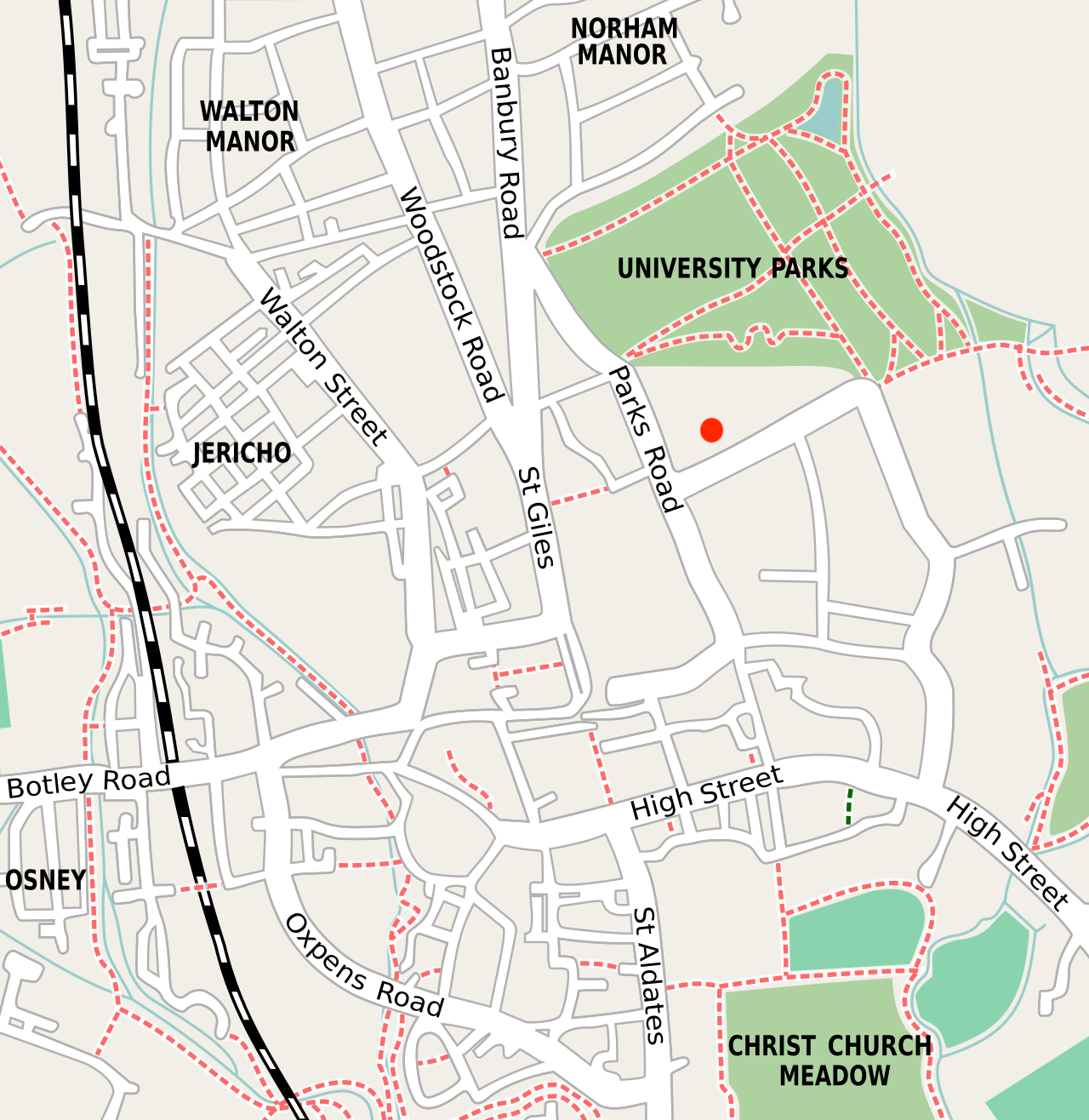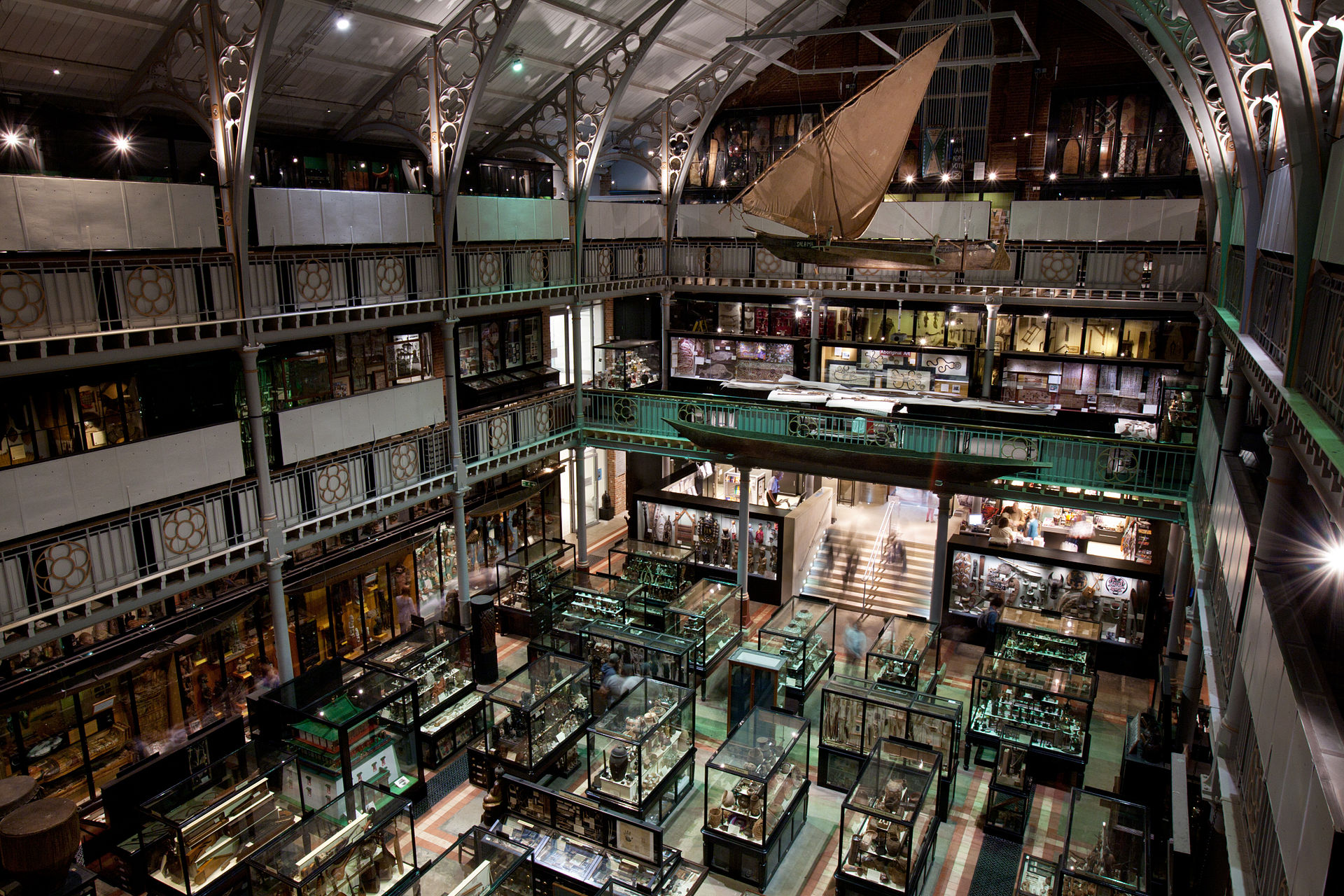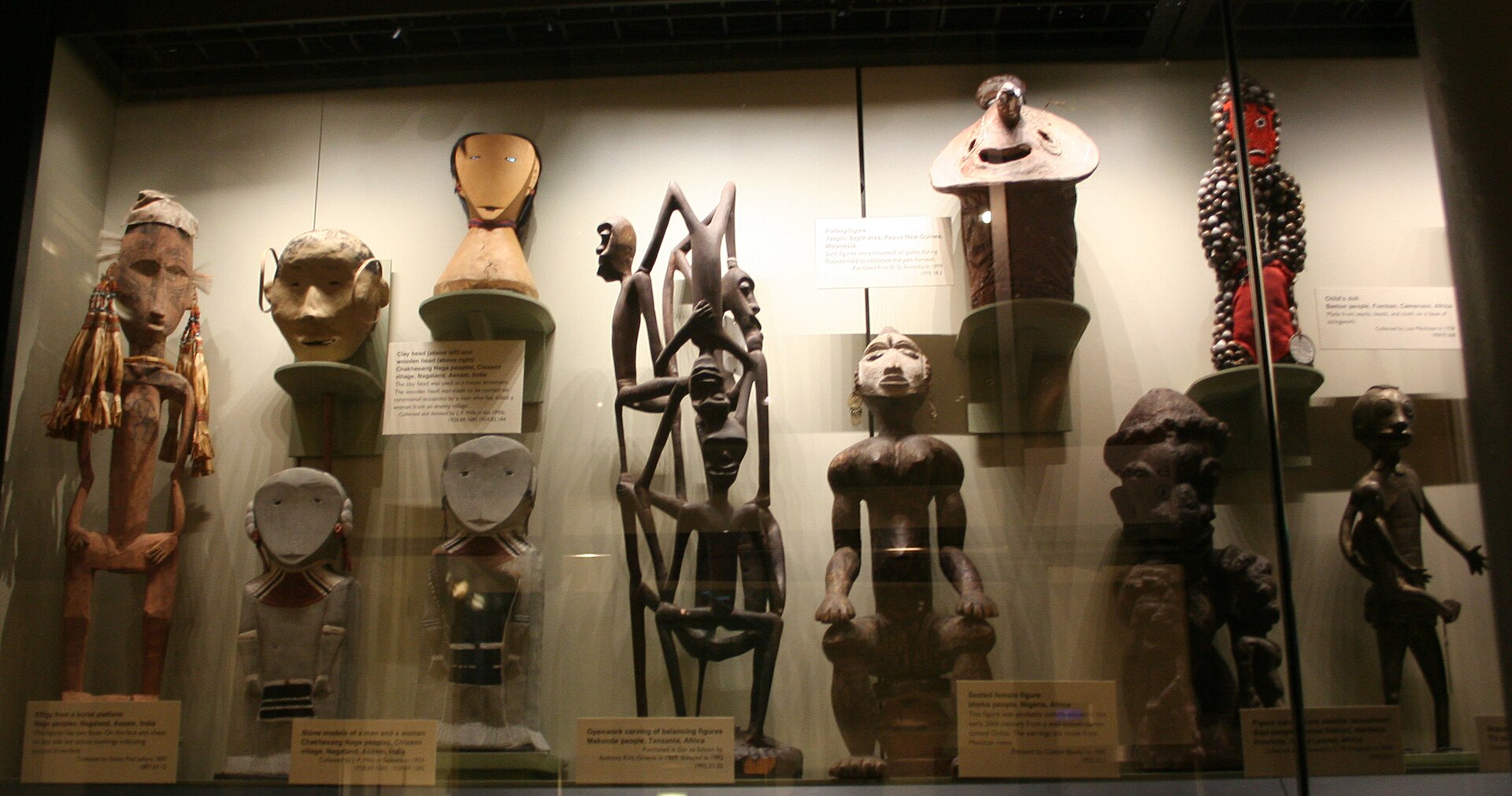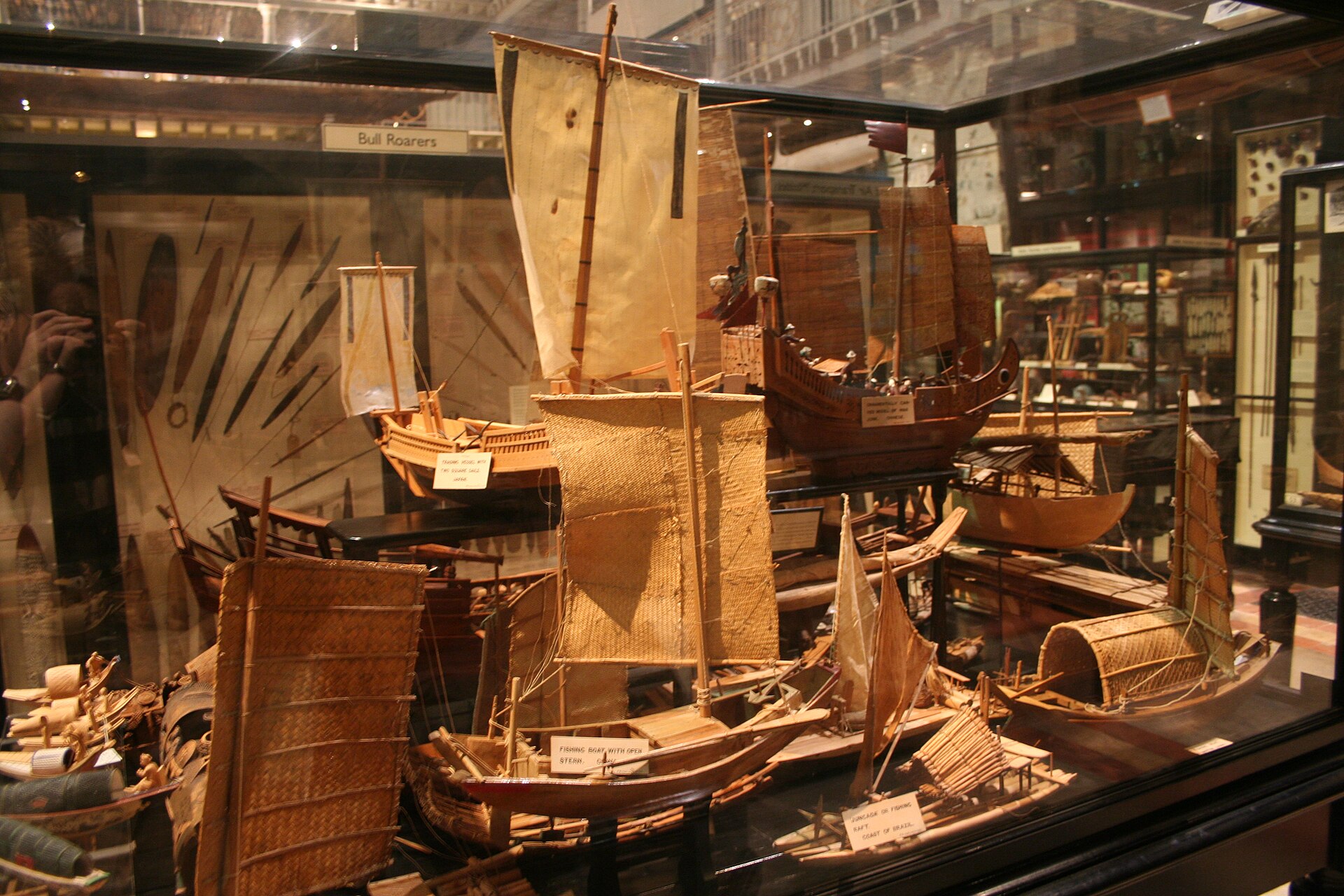
アウグストゥス・ピット・リヴァーズ
Augustus Pitt Rivers, 1827-1900

☆ オーガスタス・ヘンリー・レーン・フォックス・ピット・リバーズ准将(1827年4月14日 - 1900年5月4日)は、イギリス陸軍の将校、民族学者、考古学者であった。彼は考古学の方法論と、考古学および民族学のコレクションの博物館展示におけ る革新で有名であった。彼の国際的なコレクションは約22,000点に及び、オックスフォード大学ピット・リバーズ博物館の創設コレクションとなった。ま た、ストーンヘンジ周辺地域のイギリス考古学コレクションは、ウィルシャー州ソールズベリー博物館のコレクションの基礎となっている。 生涯の大半を通じて、彼はレーン・フォックスという姓を使用し、初期の考古学レポートはレーン・フォックスの名で出版された。1880年、彼はロード・リ バーズ(従兄弟)からクランボーン・チェイスにある32,000エーカー以上の土地を相続し、ピット・リバーズという姓を名乗るようになった。 彼の姓はしばしば「ピット=リバーズ」と綴られる。ミドルネームは「レーン=フォックス」と綴られることもある。
★ピット・リバーズ博物館(Pitt Rivers Museum)は、イギリスのオックスフォード大学が所蔵する考古学および人類学のコレクションを展示する博物館である。博物館はオックスフォード大学自然史博物館の東側に位置しており、自然史博物館を通してのみ入館できる。
| Lieutenant General
Augustus Henry Lane Fox Pitt Rivers FRS FSA FRAI (14 April 1827 – 4 May
1900) was an English officer in the British Army, ethnologist, and
archaeologist.[1] He was noted for innovations in archaeological
methodology, and in the museum display of archaeological and
ethnological collections. His international collection of about 22,000
objects was the founding collection of the Pitt Rivers Museum at the
University of Oxford while his collection of English archaeology from
the area around Stonehenge forms the basis of the collection at The
Salisbury Museum in Wiltshire.[2] Throughout most of his life he used the surname Lane Fox, under which his early archaeological reports are published. In 1880 he adopted the Pitt Rivers name on inheriting from Lord Rivers (a cousin) an estate of more than 32,000 acres in Cranborne Chase.[3] His family name is often spelled as "Pitt-Rivers".[4] His middle name is sometimes spelled as "Lane-Fox".[5][6] |
オーガスタス・ヘンリー・レーン・フォックス・ピット・リバーズ准将
(1827年4月14日 -
1900年5月4日)は、イギリス陸軍の将校、民族学者、考古学者であった[1]。彼は考古学の方法論と、考古学および民族学のコレクションの博物館展示
における革新で有名であった。彼の国際的なコレクションは約22,000点に及び、オックスフォード大学ピット・リバーズ博物館の創設コレクションとなっ
た。また、ストーンヘンジ周辺地域のイギリス考古学コレクションは、ウィルシャー州ソールズベリー博物館のコレクションの基礎となっている[2]。 生涯の大半を通じて、彼はレーン・フォックスという姓を使用し、初期の考古学レポートはレーン・フォックスの名で出版された。1880年、彼はロード・リ バーズ(従兄弟)からクランボーン・チェイスにある32,000エーカー以上の土地を相続し、ピット・リバーズという姓を名乗るようになった[3]。 彼の姓はしばしば「ピット・リバーズ」と綴られる[4]。ミドルネームは「レーン・フォックス」と綴られることもある[5][6]。 |
| Early life and family Born Augustus Henry Lane-Fox at Bramham cum Oglethorpe near Wetherby in Yorkshire,[7] he was the son of William Lane-Fox and Lady Caroline Douglas, sister of George Douglas, 17th Earl of Morton. The politicians George Lane-Fox and Sackville Lane-Fox were his uncles. In 1880, Lane Fox inherited the estates of his cousin, Horace Pitt-Rivers, 6th Baron Rivers and with it the remainder of the Richard Rigby fortune. It was "an event that transformed his life." He was required to adopt the surname Pitt-Rivers as part of the bequest 'either alone or in addition to his or their surname'.[8] On 3 February 1853,[9] Pitt-Rivers (still under the surname Fox) married The Honourable Alice Margaret Stanley (1828–1910), daughter of the politician Edward Stanley, 2nd Baron Stanley of Alderley and of the women's education campaigner Henrietta Stanley, Baroness Stanley of Alderley. Alice had a slew of siblings active in the public issues of the day, several of whom married into prominent families. The Pitt Rivers Museum suggests that some of the founding collection, particularly some Indian items, may have come from John Constantine Stanley (1837-1878), younger brother of Alice.[10] |
生い立ちと家族 オーガスタス・ヘンリー・レーン・フォックスは、ヨークシャー州ウェザービー近郊のブラムハム・カム・オグルソープで生まれた[7]。ウィリアム・レー ン・フォックスとジョージ・ダグラス第17代モートン伯爵の妹キャロライン・ダグラスの間の子である。政治家ジョージ・レーン・フォックスとサックヴィ ル・レーン・フォックスは彼の叔父にあたる。 1880年、レーン・フォックスは従兄弟のホレス・ピット=リバーズ第6代リバーズ男爵の遺産を相続し、リチャード・リグビーの財産も受け継いだ。これは 「彼の人生を一変させる出来事」であった。彼は遺産の一部として「単独で、または彼または彼らの姓に加えて」ピット=リバーズ姓を名乗るよう求められた [8]。1853年2月3日[9]、ピット=リバーズ(まだ姓はフォックス)は 政治家エドワード・スタンレー(第2代スタンレー・オブ・アルダーリー男爵)と女性教育運動家ヘンリエッタ・スタンレー(スタンレー・オブ・アルダーリー 女男爵)の娘、アリス・マーガレット・スタンレー(1828年~1910年)と結婚した。アリスには、当時の公共問題に関与していた多くの兄弟姉妹がお り、そのうちの何人かは名門の家庭に嫁いだ。ピット・リバーズ博物館は、創設時のコレクション、特にインドの品々の一部は、アリスの弟ジョン・コンスタン ティン・スタンリー(1837-1878)から提供された可能性があると示唆している[10]。 |
| Descendants Augustus and Alice had nine children who reached adulthood; they were born between 1855 and 1866.[11] As they were all born before Augustus took the new surname in 1880, their births are registered under the name of Fox (or Lane-Fox). Alexander Edward Lane Fox-Pitt-Rivers, 2 November 1855 – 19 August 1927. St. George Lane Fox-Pitt, 14 September 1856 – 6 April 1932, electrical engineer, author, and student of psychic phenomena. William Augustus Lane Fox-Pitt, 9 January 1858 – 1945?. Ursula Katharine Lane Fox-Pitt, 1859? – 1942. Lionel Charles Lane Fox-Pitt, 5 November 1860 – 1937?. Alice Augusta Laurentia Lane Fox-Pitt, circa 1862 – 11 March 1947. Agnes Geraldine Fox-Pitt, 25 July 1863 – 7 December 1926.[12] Douglas Henry Lane Fox-Pitt, 17 December 1864 – 19 September 1922. Arthur Algernon Lane Fox-Pitt, 12 April 1866 – 6 November 1895. Augustus' descendants include his grandson, anthropologist, eugenicist, and anti-Semite George Pitt-Rivers, who was interned in 1940 under Defence Regulation 18B.[13] George's children included Michael Pitt-Rivers, and his brother, anthropologist and ethnographer, Julian A. Pitt-Rivers. A further generation includes Augustus's great-great-grandson, equestrian William Fox-Pitt. |
子孫 オーガスタスとアリスには9人の子供がおり、全員が成人した。1855年から1866年の間に生まれた[11]。オーガスタスが1880年に姓を変えた前に生まれたため、彼らの出生はフォックス(またはレーン・フォックス)の名で登録されている。 アレクサンダー・エドワード・レーン・フォックス=ピット=リバーズ、1855年11月2日 - 1927年8月19日。 セント・ジョージ・レーン・フォックス・ピット、1856年9月14日~1932年4月6日、電気技師、作家、心霊現象の研究者。 ウィリアム・オーガスタス・レーン・フォックス・ピット、1858年1月9日~1945年? ウルズラ・キャサリン・レーン・フォックス・ピット、1859年?~1942年。 ライオネル・チャールズ・レーン・フォックス・ピット、1860年11月5日~1937年? アリス・オーガスタ・ローレンシア・レーン・フォックス・ピット、1862年頃~1947年3月11日。 アグネス・ジェラルディン・フォックス・ピット、1863年7月25日~1926年12月7日[12]。 ダグラス・ヘンリー・レーン・フォックス・ピット、1864年12月17日~1922年9月19日。 アーサー・アルジャーノン・レーン・フォックス・ピット、1866年4月12日~1895年11月6日。 オーガスタスの子孫には、孫で人類学者、優生学者、反ユダヤ主義者のジョージ・ピット=リバーズがいる。彼は1940年に国防規則18Bに基づき抑留され た[13]。ジョージの子供たちにはマイケル・ピット=リバーズ、そして彼の兄弟で人類学者、民族誌学者のジュリアン・A・ピット=リバーズがいる。さら にその世代にはオーガスタスの曾曾孫で騎手のウィリアム・ピット=リバーズがいる。 |
| Military career Lane Fox had a long and successful military career as a staff officer. He was educated at the Royal Military College, Sandhurst, for six months at the age of fourteen and was commissioned into the Grenadier Guards on 16 May 1845 as an ensign.[14] In the course of a thirty-two-year military career, albeit much interrupted by leave, he only once saw major front line action, at the Battle of Alma in 1854. Soon after the battle, he was found unfit for active service and returned to England.[8] In 1851 he became a member of the committee to experiment and report on the respective merits of the army's smoothbore muskets. He was appointed to Woolwich to instruct in the use of the new Minié rifle in 1852. Subsequently, he was largely responsible for founding the Hythe school of Musketry in Kent and became its principal instructor, revising its Instruction of Musketry manual. The remainder of his service career revolved around musketry instruction and in 1858 he published a paper On the improvement of the rifle as a weapon for general use.[15][16] He bought a promotion to captain on 2 August 1850.[17] He was promoted to the brevet rank of lieutenant-colonel of the army "for distinguished Service in the Field" during the Crimean War.[18] On 15 May 1857, he bought the rank of lieutenant-colonel in the Grenadier Guards.[19] The then Brevet-Major Lane Fox, was appointed a member of the Fifth Class of the Order of the Medjidie in 1858 for "distinguished services before the enemy during the [Crimean War]".[20] He was promoted to colonel on 22 January 1867[21] and major general in 1877.[22] Pitt Rivers retired in 1882 and was accorded the honorary rank of Lt General. |
軍歴 レーン・フォックスは幕僚として長く軍務に就き、成功を収めた。14歳のときにサンドハースト王立陸軍士官学校で6か月間教育を受け、1845年5月16 日に少尉として近衛歩兵連隊に任官した[14]。休暇で中断されることも多かったが、32年間の軍歴の中で、1854年のアルマ戦役で初めて前線での主要 な戦闘を経験した。戦闘後まもなく、彼は現役復帰には不適格と判断され、イギリスに戻った[8]。1851年、彼は陸軍の滑腔銃それぞれの長所について実 験し報告する委員会のメンバーとなった。1852年、彼はウーリッジに任命され、新型のミニエ銃の使用方法を指導した。その後、彼はケント州ハイス銃術学 校の設立に多大な貢献をし、主任教官となり、銃術教則書を改訂した。彼の軍人としてのキャリアの残りは、銃術の指導に費やされ、1858年には「一般使用 のための武器としてのライフル銃の改善」に関する論文を発表した[15][16]。1850年8月2日に大尉に昇進した[17]。クリミア戦争中の「戦場 での顕著な功績」により、陸軍准将の階級に昇進した クリミア戦争中の「戦場における顕著な功績」により陸軍准将に昇進した[18]。1857年5月15日、彼は近衛歩兵連隊の少佐の階級を購入した [19]。当時准将であったレーン・フォックスは、1858年に「クリミア戦争中の敵前における顕著な功績」により、メジディ勲章の第5等級に任命された 1858年、「(クリミア戦争中の)敵前における顕著な功績」により、1858年にブレベット少佐のレーン・フォックスは、メジディ勲章の第5等級に任命 された[20]。彼は1867年1月22日に大佐に昇進し[21]、1877年には少将に任命された[22]。ピット・リヴァーズは1882年に退役し、 名誉少将の称号を授与された。 |
| Archaeological career Pitt Rivers' interests in archaeology and ethnology began in the 1850s, during postings overseas, and he became a noted scientist while he was a serving military officer. His interest began with the evolution of the rifle, which extended to other weapons and tools, and he became a collector of artifacts illustrating the development of human invention. His collection became famous, and, after being exhibited in 1874–1875 at the Bethnal Green Museum, London, was presented in 1885 to the University of Oxford.[23] He was elected, in the space of five years, to the Ethnological Society of London (1861), the Society of Antiquaries of London (1864) and the Anthropological Society of London (1865). In 1867, Pitt Rivers left full-time military service and went on half pay.[24] The same year, he visited an archaeological excavation being carried out in the Yorkshire Wolds by Canon William Greenwell, librarian of Durham Cathedral and an established archaeologist, to whom he may have been introduced by mutual friends George Rolleston or Albert Way. Pitt Rivers received his first instruction in excavation from Greenwell, and later described himself as Greenwell's pupil.[24][25] Greenwell viewed archaeology as a serious scholarly process of assembling evidence on periods which lacked written records, contrasted to the "ignorant and greedy spirit of mere curiosity-hunting"; views that would influence Pitt Rivers' own approach.[26][24] By the time he retired, he had amassed ethnographic collections numbering tens of thousands of items from all over the world. Influenced by the evolutionary writings of Charles Darwin and Herbert Spencer, he arranged them typologically and (within types) chronologically. He viewed archaeology as an extension of anthropology and, as consequence, built up matching collections of archaeological and ethnographic objects to show longer developmental sequences to support his views on cultural evolution.[27] This style of arrangement, designed to highlight evolutionary trends in human artefacts, was a revolutionary innovation in museum design. Pitt Rivers' ethnological collections form the basis of the Pitt Rivers Museum which is still one of Oxford's attractions. His researches and collections cover periods from the Lower Paleolithic to Roman and medieval times, and extend all over the world.[28] The Pitt Rivers Museum curates more than half a million ethnographic and archaeological artifacts, photographic and manuscript collections from all parts of the world. The museum was founded in 1884 when the university accepted the gift of more than 20,000 artifacts from Pitt Rivers. The university awarded him the Doctorate of Civil Law in 1886, and he was later named a Fellow of the Royal Society.[22] The collections continue to grow, and the museum has been described as one of the "six great ethnological museums of the world".[29] Pitt Rivers' Wessex Collection is housed in The Salisbury Museum, not far from Stonehenge. The Wessex Gallery of archaeology opened in 2014, funded by the Heritage Lottery Fund and other sources. Pitt Rivers and other early archaeologists such as William Stukeley who first investigated the prehistory of Wiltshire, Cranborne Chase, Avebury and Stonehenge, are celebrated in the gallery. The estates Pitt Rivers inherited in 1880 contained a wealth of archaeological material from the Roman and Saxon periods. He excavated these over seventeen seasons, from the mid-1880s until his death. His approach was highly methodical by the standards of the time, and he is widely regarded as the first scientific archaeologist to work in Britain. His most important methodological innovation was his insistence that all artefacts, not just beautiful or unique ones, be collected and catalogued. This focus on everyday objects as the key to understanding the past broke decisively with earlier archaeological practice, which verged on treasure hunting. It is Pitt Rivers' most important, and most lasting, scientific legacy. His work inspired Mortimer Wheeler, among others, to add to the scientific approach of archaeological excavation techniques. Following the passage of the Ancient Monuments Protection Act 1882, Pitt Rivers became the first Inspector of Ancient Monuments: a post created by anthropologist and parliamentarian John Lubbock who married Pitt Rivers' daughter, Alice. Charged with cataloguing archaeological sites and protecting them from destruction, he worked with his customary methodical zeal but was hampered by the limitations of the law, which gave him little real power over the landowners on whose property the sites stood. On the advice of Pitt-Rivers, Kit's Coty House and Little Kit's Coty House, Kent, were among the first ancient British remains to be protected by the state. Railings were erected around the stones there to prevent vandalism.[30] Pitt Rivers was a leading member of the Wiltshire Archaeological and Natural History Society, and was president of the society from 1890[31] to 1893.[32] |
考古学におけるキャリア ピット・リヴァーズの考古学と民族学への関心は、1850年代に海外勤務中に始まり、現役軍人であった彼は著名な科学者となった。 彼の関心はライフル銃の進化から始まり、他の武器や道具にも広がった。そして、彼は人間の発明の発展を示す人工物の収集家となった。彼のコレクションは有 名になり、1874年から1875年にロンドンのベスナル・グリーン博物館で展示された後、1885年にオックスフォード大学に寄贈された[23]。彼は 5年の間に、ロンドン民族学会(1861年)、ロンドン古物学会(1864年)、ロンドン人類学会(1865年)の会員に選出された。 1867年、ピット・リヴァーズは正規の軍務を離れ、半減俸となった[24]。同年、彼は、ダラム大聖堂の司書であり、著名な考古学者でもあったウィリア ム・グリーンウェル大司教がヨークシャー・ウォルズで行っていた考古学発掘調査を訪れた。ピット・リヴァーズはグリーンウェルから発掘の初歩的な指導を受 け、後にグリーンウェルの弟子であると自称した[24][25]。グリーンウェルは、考古学を、文字による記録がない時代に関する証拠を収集する真剣な学 問的プロセスと捉えていた。 単なる好奇心による無知で貪欲な精神」とは対照的であり、この考え方はピットの考古学へのアプローチに影響を与えた[26][24]。 彼は退職するまでに、世界各地から集めた何万点もの民族誌的コレクションを蓄積していた。チャールズ・ダーウィンとハーバート・スペンサーの進化論的著作 に影響を受けた彼は、それらを類型学的に分類し、(類型ごとに)年代順に並べた。彼は考古学を人類学の延長線上にあるものと捉え、その結果、文化進化に関 する自身の見解を裏付けるために、考古学と民族学のコレクションを組み合わせて、より長い発展の過程を示すコレクションを構築した[27]。人間の工芸品 における進化の流れを強調するように設計されたこの分類方法は、博物館設計における画期的な革新であった。 ピット・リバーズの民族学コレクションは、現在もオックスフォードの観光スポットであるピット・リバーズ博物館の基礎となっている。彼の研究とコレクショ ンは、旧石器時代からローマ時代、中世までの時代を網羅し、世界中に及んでいる[28]。ピット・リバーズ博物館は、世界各地から集められた50万点以上 の民族学・考古学資料、写真、原稿コレクションを所蔵している。この博物館は、1884年にピト・リヴァースから20,000点以上の遺物が寄贈されたこ とを受けて設立された。大学は1886年に彼に民法博士号を授与し、後に彼は王立協会のフェローに任命された[22]。コレクションは増え続け、この博物 館は「世界の6大民族学博物館」のひとつとして知られている[29]。 ピット・リバーズのウェセックス・コレクションは、ストーンヘンジからほど近いソールズベリー博物館に収蔵されている。2014年、遺産宝くじ基金などの 資金援助により、ウェセックス考古学ギャラリーがオープンした。ピット・リバーズや、ウィルトシャー、クランボーン・チェイス、エイブベリー、ストーンヘ ンジの有史以前を初めて調査したウィリアム・スタックリーなどの初期の考古学者たちは、このギャラリーで称えられている。 ピット・リバーズが1880年に相続した遺産には、ローマ時代とサクソン時代の考古学資料が豊富に含まれていた。彼は1880年代半ばから亡くなるまでの 17シーズンにわたって発掘調査を行った。彼のアプローチは当時の基準から見て非常に体系的であり、彼は英国で初めて科学的な考古学に取り組んだ人物とし て広く知られている。彼の最も重要な方法論上の革新は、美しいものやユニークなものだけでなく、すべての遺物を収集し、カタログ化するという主張であっ た。過去を理解する鍵として日常的な品物に焦点を当てるというこの方法は、宝探しに近い従来の考古学的方法論と決定的に決別するものだった。これは、ピッ ト・リバーズのもっとも重要かつ最も永続的な科学的遺産である。彼の業績は、モートマー・ウィーラーをはじめとする人々を刺激し、考古学的発掘技術の科学 的アプローチに新たな展開をもたらした。 1882年に古代遺跡保護法が制定された後、ピット・リバーズは初代古代遺跡監督官に就任した。このポストは、ピット・リバーズの娘アリスと結婚した人類 学者で国会議員のジョン・ラブックが創設した。彼は、考古学遺跡の分類と破壊からの保護を任務とし、いつものように几帳面な熱意を持って仕事に取り組んだ が、遺跡が建つ土地の地主に対してほとんど実権を持たないという法律の制限に悩まされた。ピット=リヴァースの助言により、キットのコティ・ハウスとリト ル・キットのコティ・ハウス(ケント州)は、国家によって保護された最初の英国古代遺跡となった。そこにある石には、破壊行為を防ぐために手すりが取り付 けられた[30]。 ピット=リヴァースは、ウィルシャー考古学・自然史協会の主要メンバーであり、1890年から1893年まで会長を務めた[31][32]。 |
| Other interests The Rushmore estate near Tollard Royal in Wiltshire was part of his 1880 inheritance, and there he created the Larmer Tree Gardens, a pleasure garden which was opened to the public in 1885.[33] In 1884 he served as High Sheriff of Dorset.[34] Memorial to Augustus Pitt Rivers in St Peter's Church at Tollard Royal Pitt Rivers was an advocate for cremation. Even though many people believed that it was immoral to destroy a corpse, the cremation movement favoured a practical way to dispose of bodies. Pitt Rivers was cremated after his death in 1900. |
その他の関心事 ウィルシャー州トラードル・ロイヤル近郊にあるラッシュモア荘園は、1880年に彼が相続した財産の一部であり、そこで彼はラマーツリー・ガーデンズという娯楽庭園を建設し、1885年に一般公開した[33]。 1884年にはドーセット州の高等保安官を務めた[34]。 トラードル・ロイヤルにあるセントピーターズ教会にあるオーガスタス・ピット・リバーズを記念する碑 ピット・リバーズは火葬の支持者であった。死体を処分することは不道徳だと考える人も多かったが、火葬運動は死体の処理に現実的な方法を提供した。ピット・リバーズは1900年に死去した後、火葬された。 |
| Bibliography Among the publications of August Pitt Rivers are: Fox, Lane (1858). On the improvement of the rifle, as a weapon for general use. London: W. Clowes and Sons. OCLC 85009924 (all editions). Retrieved 2 August 2020. Excavations on Cranborne Chase (4 volumes) Excavations on Bokerly and Wansdyke |
オーガスト・ピット・リヴァーズの出版物は以下の通りである。 Fox, Lane (1858). On the improvement of the rifle, as a weapon for general use. London: W. Clowes and Sons. OCLC 85009924 (all editions). Retrieved 2 August 2020. クランボーン・チェイスでの発掘調査(全4巻) ボッケリーとワンズダイクでの発掘調査 |
| https://en.wikipedia.org/wiki/Augustus_Pitt_Rivers |
|
 Pitt Rivers Museum
is a museum displaying the archaeological and anthropological
collections of the University of Oxford in England.[2] The museum is
located to the east of the Oxford University Museum of Natural History,
and can only be accessed through that building. Pitt Rivers Museum
is a museum displaying the archaeological and anthropological
collections of the University of Oxford in England.[2] The museum is
located to the east of the Oxford University Museum of Natural History,
and can only be accessed through that building.The museum was founded in 1884 by Augustus Pitt Rivers, who donated his private collection to the University of Oxford with the condition that a permanent lecturer in anthropology must be appointed. Edward Burnett Tylor thereby became the first lecturer in anthropology in the UK following his appointment to the post of Reader in Anthropology in 1885.[3] Museum staff are still involved in teaching archaeology and anthropology at the university. The first curator of the museum was Henry Balfour. A second stipulation in the Deed of Gift was that a building should be provided to house the collection and used for no other purpose. The university therefore engaged Thomas Manly Deane, son of Thomas Newenham Deane who, together with Benjamin Woodward, had designed and built the original Oxford University Museum of Natural History building three decades earlier, to create an adjoining building at the rear of the main building to house the collection. Construction started in 1885 and was completed in 1886. The original donation consisted of approximately 22,000 items; this has now grown to more than 500,000 items, many of which have been donated by travelers, scholars, and missionaries. |
 ピット・リバーズ博物館は、イギリスのオックスフォード大学が所蔵する考古学および人類学のコレクションを展示する博物館である[2]。博物館はオックスフォード大学自然史博物館の東側に位置しており、自然史博物館を通してのみ入館できる。 ピット・リバーズ博物館は、イギリスのオックスフォード大学が所蔵する考古学および人類学のコレクションを展示する博物館である[2]。博物館はオックスフォード大学自然史博物館の東側に位置しており、自然史博物館を通してのみ入館できる。博物館は1884年にオーガスタス・ピット・リバーズによって設立された。彼はオックスフォード大学に自身のコレクションを寄贈し、その条件として人類学 の常任講師を任命することを求めた。1885年に人類学の講師に任命されたエドワード・バーネット・タイラーは、英国初の人類学講師となった[3]。博物 館のスタッフは現在も大学で考古学と人類学の教育に携わっている。博物館の初代学芸員はヘンリー・バルフォアであった。寄贈証書の2つ目の条項は、コレク ションを保管する建物を提供し、他の目的には使用しないというものであった。そのため、大学は、30年前にベンジャミン・ウッドワードとともにオックス フォード大学自然史博物館の最初の建物を設計・建設したトーマス・ニューナム・ディーンの息子、トーマス・マンリー・ディーンを雇い、コレクションを収容 する本館裏手に隣接する建物を建設させた。建設は1885年に始まり、1886年に完成した。 当初の寄贈品はおよそ22,000点だったが、現在では500,000点以上に増え、その多くは旅行者、学者、宣教師からの寄贈品である。 |
| Organization The exhibition space in the museum's building is a large, rectangular, colonnaded room. It has two mezzanine levels and a massive, vaulted ceiling, and is brimming with glass display cases and exhibits.[4] The museum's collection is arranged typologically, according to how the objects were used, rather than according to their age or origin. The display of many examples of a particular type of tool or artifact, showing historical and regional variations, is an unusual and distinct feature of this museum.[5] This topological layout is based upon Augustus Henry Lane Fox Pitt Rivers' theories; he intended for his collection to show progression in design and evolution in human culture from the simple to the complex. Although this evolutionary approach to material culture is no longer appropriate in the modern display paradigm for archaeological and anthropological objects, the museum has broadly retained the original typological organization due to the Pitt Rivers Deed of Gift which stipulated that any changes to the displays "shall not affect the general principle originated by Augustus Henry Lane Fox Pitt Rivers".[6] As the museum has an extensive collection of objects, those on display are changed periodically.[7] The museum was closed from 17 March 2020[8] to 22 September 2020[9] due to the COVID-19 pandemic. During this closure, a decision was made to remove displays of shrunken heads as well as other human remains. The museum's director issued a statement, "Exhibiting Tsantsas (shrunken heads) reinforced racist and stereotypical thinking that goes against the museum’s core values.”[10] The shrunken heads had been on display since the 1940s.[11][12] |
組織 博物館の建物の展示スペースは、長方形の大きな列柱のある部屋である。2つの中2階があり、巨大なアーチ型の天井があり、ガラスケースや展示品でいっぱいである[4]。 博物館のコレクションは、年代や起源ではなく、その物がどのように使われたかによって分類されている。特定の種類の道具や人工物の多くの例を展示し、歴史 的および地域的な変化を示すことは、この博物館の珍しい特徴である[5]。このトポロジカルなレイアウトは、オーガスタス・ヘンリー・レーン・フォック ス・ピット・リヴァーズの理論に基づいている。彼は、自分のコレクションが、単純なものから複雑なものへと、デザインにおける進歩と人類の文化の進化を示 すことを意図していた。この物質文化に対する進化論的アプローチは、考古学や人類学的な展示物に対する現代の展示パラダイムではもはや適切ではないが、博 物館はピット・リバーズ寄贈証書により、展示内容の変更は「オーガスタス・ヘンリー・レーン・フォックス・ピット・リバーズが打ち出した基本原則に影響を 及ぼさない」[6]と規定されているため、当初の類型学的構成を概ね維持している。この博物館は膨大な数のコレクションを所有しているため、展示品は定期 的に入れ替えられている[7]。 博物館は、2020年3月17日から9月22日まで、新型コロナウイルス感染症(COVID-19)の流行により休館していた[8][9]。この閉鎖期間 中には、縮み頭やその他の人骨を展示から外す決定がなされた。博物館の館長は、「ツァンタス(縮み頭)を展示することは、博物館のコアバリューに反する人 種差別的かつ固定観念的な考え方を助長する」という声明を発表した[10]。縮み頭は1940年代から展示されていた[11][12]。 |
The Haida Totem Pole The Haida totem pole, from Star House in Massett village on Haida Gwaii (the Queen Charlotte Islands), Canada The largest object on display in the museum is the Haida house post, a totem pole, which has a height of 11.36m. It originally stood in front of the Star House in the village of Old Massett (Haida name Uttewas), on Graham Island, in British Columbia, Canada. The Star House belonged to Chief Anetlas (c.1816–1893); it is thought that the house was constructed in 1882. The pole was purchased by Edward Burnett Tylor and transported to the Pitt Rivers Museum in 1901.[13][14][15] |
ハイダのトーテムポール カナダ、クイーン・シャーロット諸島、ハイダ・グワイ(Haida Gwaii)のマセット村にあるスター・ハウス(Star House)のハイダのトーテムポール 博物館で展示されている最大の展示物は、高さ11.36mのハイダのトーテムポール、ハイダの家の柱である。このトーテムポールは、もともとカナダのブリ ティッシュコロンビア州、グラハム島にあるオールド・マセット(Haida名:ウッテワス)の村のスター・ハウスの前に立っていた。スターハウスはチー フ・アネットラス(1816年頃~1893年)の所有物であり、1882年に建てられたと考えられている。ポールはエドワード・バーネット・タイラーに よって購入され、1901年にピットリバーズ博物館に運ばれた[13][14][15]。 |
 |
The Pitt Rivers Museum |
 |
Figures from around the world |
 |
Fishing boat models from around the world |
 |
Japanese Noh masks |
 |
Witch in a Bottle, Hove, Sussex |
 |
Shrunken head, photo circa 2009. This item, as well as most other human remains, were removed from display in 2020. |
| Expansion Despite the Pitt Rivers being so full as to be "bursting at the seams", designs for a new museum building in the 1960s were never realised.[16]: 41 By 1964, the university wanted to expand the science area onto the Pitts Rivers site and move the museum to a larger plot on Banbury Road.[16]: 41 A round museum was proposed, covering a site larger than the Sheldonian Theatre, the Clarendon Building, and the Bodleian Library combined.[16]: 41 The concept was strongly supported by the museum's curator Bernard Fagg and, after concerted lobbying from Fagg, the university's Standing Committee on Museums and Galleries.[16]: 41 In February 1966, the university greenlit the new museum and promised to keep the Banbury Road site free for three years while funding was arranged.[16]: 43 Several architects were considered for the project including Leslie Martin (who was already working on plans for a new zoology building), Powell & Moya, and Pier Luigi Nervi; Nervi was selected and planning applications were submitted and approved by Oxford City Council in a 32-29 vote.[16]: 43 The new museum needed £4.5 million to cover construction costs and £2.25 million as an endowment.[16]: 43 In May 1968, Fagg suffered a stroke which left him in hospital until the end of the academic year and significantly limited his involvement in fundraising efforts.[16]: 46 [17] By 1970, the campaign had lost momentum, the fundraising committee dissolved, and in September, the university announced the project would be shelved.[16]: 46 In 2004, the museum received £3,700,000 from the Higher Education Funding Council for England (HEFCE) to build an annex adjoining the museum. Building work was completed in 2007, bringing the academic staff of the museum back to the site, and providing a laboratory for conservation of the specimens. A second phase of development began on 7 July 2008 necessitating the closure of the museum and galleries. The museum reopened on 1 May 2009.[18] In this work, the 1960s exhibition gallery was dismantled, restoring the original view through to the museum's totem pole. Original display cases were returned to their original place at the front of the museum. The space upstairs vacated by these cases provides additional space for a Clore Duffield Education Centre. A new entrance platform was built to allow visitors to enter on the same level as the Oxford University Museum of Natural History and improves access for wheelchair users and parents with pushchairs. The entrance platform provides re-located shop and reception areas. An environmental control system was also installed.[19] |
拡張 ピット=リヴァースは「はち切れんばかり」に溢れていたにもかかわらず、1960年代に計画された新しい博物館の建設は実現しなかった[16]: 41。 1964年までに、大学はピット川沿いに科学エリアを拡大し、博物館をバンベリー・ロードのより広い敷地に移転することを望んでいた[16]: 41。円 形博物館の建設が提案され、その敷地はシェルドニアン劇場、クレアンドン棟、ボドリアン図書館を合わせたよりも広大なものとなった[16]: 41 。こ の構想は、博物館の学芸員バーナード・ファッグによって強く支持され、ファッグと大学博物館・美術館常任委員会による熱心な働きかけの結果、[16]: 41 1966年2月、 大学は新博物館の建設を承認し、資金調達が完了するまでの3年間、バンベリー・ロードの敷地を無償で提供することを約束した[16]: 43。このプロ ジェクトには、レスリー・マーティン(すでに新しい動物学棟の設計に取り組んでいた)、パウエル&モヤ、ピエル・ルイジ・ネルヴィといった複数の建築家が 候補に挙がった。最終的にネルヴィが選ばれ、計画申請が提出され、オックスフォード市議会で32対29の投票により承認された[16]: 43。32対29の投票で承認された[16]: 43 。新博物館の建設には、建設費として450万ポンド、基金として225万ポンドが必要であった [16]: 43 。1968年5月、ファッグは脳卒中を発症し、学年度末まで入院し、資金調達活動への関与を大幅に制限することとなった[16]: 46 [17] 1970年までにキャンペーンは勢いを失い、資金調達委員会は解散し、9月には大学はプロジェクトを棚上げすると発表した[16]: 46 2004年、博物館は博物館に隣接する別館を建設するために、イングランド高等教育資金協議会(HEFCE)から370万ポンドの資金援助を受けた。2007年に工事が完了し、博物館の学術スタッフが再びこの地に戻り、標本の保存のための研究室が提供された。 2008年7月7日に第2段階の開発が始まり、博物館とギャラリーは閉鎖された。博物館は2009年5月1日に再開した[18]。この工事では、1960 年代に作られた展示室が取り壊され、トーテムポールまでが元の姿に戻された。オリジナルの展示ケースは博物館正面の元の位置に戻された。これらのケースが 置かれていた2階のスペースは、クロア・ダフィールド教育センターに追加スペースとして提供された。新しいエントランス・プラットフォームが建設され、来 館者はオックスフォード大学自然史博物館と同じレベルから入館できるようになり、車椅子利用者やベビーカーを押す親子のアクセスも改善された。エントラン ス・プラットフォームには、ショップと受付エリアが移転した。また、環境制御システムも設置された[19]。 |
| Multaka network In 2019, the museum joined six similar museums in Germany, Italy, Greece and Switzerland, creating the international Multaka network. This intercultural museum project organizes guided tours for refugees and migrants designed and offered for free by specially trained Arabic-speaking Multaka guides. The visitor-centered discussions with migrants in their language are focused on the historical origin and history of acquisition of cultural objects, including the visitors' own understanding of their country's cultural heritage.[20] |
Multakaネットワーク 2019年、当博物館はドイツ、イタリア、ギリシャ、スイスの6つの同様の博物館と提携し、国際的なMultakaネットワークを設立した。この異文化博 物館プロジェクトでは、特別に訓練を受けたアラビア語を話すMultakaガイドが設計し、無料で提供する難民や移民向けのガイドツアーを開催している。 来館者中心の議論は、移住者との母国語で進められ、文化的な物品の歴史的起源や取得の歴史、来館者自身の自国の文化遺産に対する理解に焦点を当てている [20]。 |
| Awards The Pitt Rivers Museum, along with the Oxford University Museum of Natural History, won The Guardian newspaper's award for Family Friendly Museum of 2005.[21] In 2019, the Pitt Rivers Museum was finalist of the Art Fund Museum of the Year Award.[22] |
受賞 ピット・リバーズ博物館は、オックスフォード大学自然史博物館とともに、ガーディアン紙が選ぶ「ファミリーフレンドリー博物館2005」を受賞した [21]。2019年には、ピット・リバーズ博物館がアート・ファンド・ミュージアム・オブ・ザ・イヤー賞の最終選考に残った[22]。 |
| Colonial legacy In recent years, the Pitt Rivers Museum has been called sector-leading[23][failed verification] in its work on decoloniality. Further details can be found on the website.[24][Expansion needed] In September 2020, the museum announced it had made a number of critical changes to its displays,[25] including the removal from display of human remains and the installation of a new Introductory Case as an intervention in its permanent galleries that engages with the colonial legacy of the museum. The changes attracted worldwide attention as they involved the removal of the museum's collection of shrunken heads, which had been on display since the 1940s, citing the reason that "the displays reinforced racist and stereotypical thinking that goes against the museum’s values today".[26][27] The museum has also said that it would make changes to the labels to include stories "through the voices of artists and indigenous leaders".[10] As part of this process the Pitt Rivers Museum is meeting with originating communities to address errors and gaps in the information it stores, and to discuss repatriation.[28] One of these is the Living Cultures initiative, a collaboration between the museum, a Maasai community based campaign group called Oltoilo Le Maa, and community development organisation InsightShare.[29][30] Additionally, the museum, together with the Museum of Natural History, returned the remains of 17 Aboriginal Australians to the Australian government in 2022.[4] |
植民地時代の遺産 近年、ピット・リバーズ博物館は脱植民地化に関する取り組みにおいて、その分野をリードする存在[23][検証失敗]と呼ばれている。詳細はウェブサイトに掲載されている。[24][要拡大] 2020年9月、博物館は展示にいくつかの重要な変更を加えたことを発表し、[25] 人間の遺骨の展示を取りやめ、博物館の植民地時代の遺産と向き合う介入策として常設展示室に新しいイントロダクティブケースを設置した。この変更は、 1940年代から展示されていた博物館のコレクションである縮み上がった頭部の展示を取り除くというもので、「展示は、今日の博物館の価値観に反する人種 差別的かつ固定観念的な考え方を助長していた」という理由から、世界中から注目を集めた[26][27]。博物館はまた、 「アーティストや先住民のリーダーたちの声を通して」ストーリーを記載したラベルに変更するとしている[10]。 このプロセスの一環として、ピット・リバーズ博物館は、保管している情報の誤りや欠落に対処し、返還について話し合うために、原住民コミュニティと会合を 開いている[28]。その一つが「リビング・カルチャーズ」イニシアチブで、 博物館、マサイ族のコミュニティを基盤とするキャンペーン団体「オルタイロ・レ・マー」および地域開発団体「インサイトシェア」の共同プロジェクトであ る。[29][30] さらに、博物館は自然史博物館とともに、2022年にオーストラリア政府に17人のオーストラリア先住民の遺骨を返還した。[4] |
| 2024 Pro-Palestine Encampments See also: 2024 University of Oxford pro-Palestinian campus occupations Beginning on May 6th, pro-Palestine demonstrators under the name Oxford Action for Palestine (OA4P) occupied the lawns of Pitt Rivers Museum, demanding Oxford University enter negotiations about severing institutional relationships facilitating "the genocide and occupation of the Palestinian people."[31] This followed the nationwide movement in the US of pro-Palestine sit-ins and encampments protesting the escalating violence of the ongoing Israel-Hamas war. In response, the University did not commit to the protestors demands but affirmed their right to protest and freedom of speech.[32] Ultimately, following escalations involving die-ins and a second encampment outside the Radcliffe Camera and a series of marches, Oxford University began clearing the original Pitt Rivers Museum lawn encampment to be reopened for public use, and blocked entry to the space with metal fences.[33] They cited "proactive measures to protect the lawn"[34] and destroyed the recently created "Gaza Memorial Garden" planted there. |
2024年パレスチナ支援の野宿 関連項目:2024年オックスフォード大学パレスチナ支援のキャンパス占拠 5月6日より、オックスフォード・アクション・フォー・パレスチナ(OA4P)という名のパレスチナ支援デモ参加者がピット・リバーズ博物館の芝生を占拠 し 。これは、イスラエルとハマスの戦争の激化に抗議する、全米規模のパレスチナ支援の座り込みや野営運動に続くものであった。これに対し、オックスフォード 大学は抗議者の要求には応じなかったが、抗議と言論の自由の権利を認めた[32]。最終的に、ダイインやラドクリフ・カメラの外での2回目の野宿、一連の 行進などエスカレートする事態を受け、オックスフォード大学は ピット・リバーズ博物館の芝生広場を一般利用に再開するため、元々の広場を撤去し、金属フェンスで立ち入りを禁止した[33]。彼らは「芝生を守るための 積極的な措置」[34]を理由に挙げ、そこに最近作られた「ガザ記念庭園」を破壊した。 |
| Notable people See also: Category:People associated with the Pitt Rivers Museum Henry Balfour (curator) Beatrice Blackwood (curator, anthropologist) Leonard Halford Dudley Buxton (anthropologist) Elizabeth Edwards (curator, historian of photography) Bernard Fagg (curator, archaeologist) Barbara Freire-Marreco (anthropologist) Chris Gosden (archaeologist) Clare Harris (curator for Asian Collections) Schuyler Jones (American anthropologist) Margaret Staples-Browne (Makereti) (Māori anthropologist) Howard Morphy (anthropologist) Michael Palin (patron) Augustus Henry Lane Fox Pitt-Rivers (archaeologist and donor of founding collection) Edward Burnett Tylor (anthropologist) |
著名人 関連項目: ピット・リバーズ博物館関係人物カテゴリ ヘンリー・バルフォア(学芸員) ベアトリス・ブラックウッド(学芸員、人類学者) レナード・ハルフォード・ダドリー・バクストン(人類学者) エリザベス・エドワーズ(学芸員、写真史家) バーナード・ファッグ(学芸員、考古学者) バーバラ・フレイレ=マレコ(人類学者) クリス・ゴスデン(考古学者) クレア・ハリス( シュイラー・ジョーンズ(アメリカ人人類学者) マーガレット・ステイプルズ=ブラウン(マケレティ)(マオリ族人類学者) ハワード・モーフィー(人類学者) マイケル・ペイリン(パトロン) オーガスタス・ヘンリー・レーン・フォックス・ピット=リバーズ(考古学者、創設コレクションの寄贈者) エドワード・バーネット・タイラー(人類学者) |
| Museums of the University of Oxford Ashmolean Museum Museum of Oxford Museum of the History of Science, Oxford Museum of Archaeology and Anthropology, University of Cambridge |
オックスフォード大学付属博物館 アッシュモレアン博物館 オックスフォード博物館 オックスフォード大学科学史博物館 ケンブリッジ大学考古学人類学博物館 |
| https://en.wikipedia.org/wiki/Pitt_Rivers_Museum |
|
リ ンク
文 献
そ の他の情報
Copyleft, CC, Mitzub'ixi Quq Chi'j, 1996-2099
☆
 ☆
☆